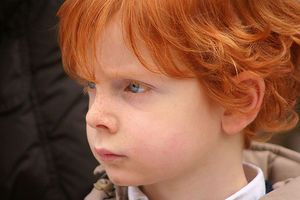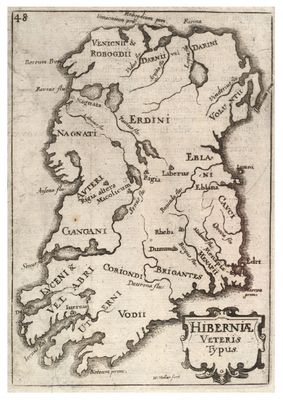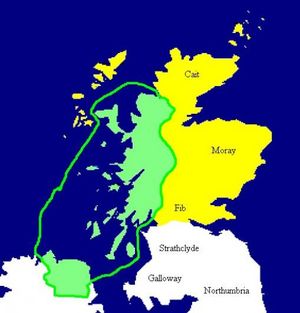
Posted on 01/11/2014 6:13:55 AM PST by NYer

The blood in Irish veins is Celtic, right? Well, not exactly. Although the history many Irish people were taught at school is the history of the Irish as a Celtic race, the truth is much more complicated, and much more interesting than that ...
Research done into the DNA of Irish males has shown that the old Anthropological attempts to define 'Irish' have been misguided. As late as the 1950s researchers were busy collecting data among Irish people such as hair colour and height, in order to categorise them as a 'race' and define them as different to the British. In fact British and Irish people are closely related in their ancestry.
Research into Irish DNA and ancestry has revealed close links with Scotland stretching back to before the Ulster Planation of the early 1600s. But the closest relatives to the Irish in DNA terms are actually from somewhere else entirely!

Medieval map of Ireland, showing Irish tribes. Irish origin myths confirmed by modern scientific evidence
The earliest settlers came to Ireland around 10,000 years ago, in Stone Age times. There are still remnants of their presence scatter across the island. Mountsandel in Coleraine in the North of Ireland is the oldest known site of settlement in Ireland - remains of woven huts, stone tools and food such as berries and hazelnuts were discovered at the site in 1972.
But where did the early Irish come from? For a long time the myth of Irish history has been that the Irish are Celts. Many people still refer to Irish, Scottish and Welsh as Celtic culture - and the assumtion has been that they were Celts who migrated from central Europe around 500BCE. Keltoi was the name given by the Ancient Greeks to a 'barbaric' (in their eyes) people who lived to the north of them in central Europe. While early Irish art shows some similarities of style to central European art of the Keltoi, historians have also recognised many significant differences between the two cultures.
The latest research into Irish DNA has confirmed that the early inhabitants of Ireland were not directly descended from the Keltoi of central Europe. In fact the closest genetic relatives of the Irish in Europe are to be found in the north of Spain in the region known as the Basque Country. These same ancestors are shared to an extent with the people of Britain - especially the Scottish.
DNA testing through the male Y chromosome has shown that Irish males have the highest incidence of the haplogroup 1 gene in Europe. While other parts of Europe have integrated contiuous waves of new settlers from Asia, Ireland's remote geographical position has meant that the Irish gene-pool has been less susceptible to change. The same genes have been passed down from parents to children for thousands of years.
This is mirrored in genetic studies which have compared DNA analysis with Irish surnames. Many surnames in Irish are Gaelic surnames, suggesting that the holder of the surname is a descendant of people who lived in Ireland long before the English conquests of the Middle Ages. Men with Gaelic surnames, showed the highest incidences of Haplogroup 1 (or Rb1) gene. This means that those Irish whose ancestors pre-date English conquest of the island are direct descendants of early stone age settlers who migrated from Spain.

The Kingdom of Dalriada c 500 AD is marked in green. Pictish areas marked yellow. Irish and British DNA : a comparison
Irish origin myths confirmed by modern scientific evidence
One of the oldest texts composed in Ireland is the Leabhar Gabhla, the Book of Invasions. It tells a semi-mythical history of the waves of people who settled in Ireland in earliest time. It says the first settlers to arrive in Ireland were a small dark race called the Fir Bolg, followed by a magical super-race called the Tuatha de Danaan (the people of the goddess Dana).
Most interestingly, the book says that the group which then came to Ireland and fully established itself as rulers of the island were the Milesians - the sons of Mil, the soldier from Spain. Modern DNA research has actually confirmed that the Irish are close genetic relatives of the people of northern Spain.
While it might seem strange that Ireland was populated from Spain rather than Britain or France, it is worth remembering that in ancient times the sea was one of the fastest and easiest ways to travel. When the land was covered in thick forest, coastal settlements were common and people travelled around the seaboard of Europe quite freely.
I live in Northern Ireland and in this small country the differences between the Irish and the British can still seem very important. Blood has been spilt over the question of national identity.
However, the lastest research into both British and Irish DNA suggests that people on the two islands have much genetically in common. Males in both islands have a strong predominance of Haplogroup 1 gene, meaning that most of us in the British Isles are descended from the same Spanish stone age settlers.
The main difference is the degree to which later migrations of people to the islands affected the population's DNA. Parts of Ireland (most notably the western seaboard) have been almost untouched by outside genetic influence since hunter-gatherer times. Men there with traditional Irish surnames have the highest incidence of the Haplogroup 1 gene - over 99%.
At the same time London, for example, has been a mutli-ethnic city for hundreds of years. Furthermore, England has seen more arrivals of new people from Europe - Anglo-Saxons and Normans - than Ireland. Therefore while the earliest English ancestors were very similar in DNA and culture to the tribes of Ireland, later arrivals to England have created more diversity between the two groups.
Irish and Scottish people share very similar DNA. The obvious similarities of culture, pale skin, tendancy to red hair have historically been prescribed to the two people's sharing a common celtic ancestry. Actually it now seems much more likely that the similarity results from the movement of people from the north of Ireland into Scotland in the centuries 400 - 800 AD. At this time the kingdom of Dalriada, based near Ballymoney in County Antrim extended far into Scotland. The Irish invaders brought Gaelic language and culture, and they also brought their genes.
Irish Characteristics and DNA
The MC1R gene has been identified by researchers as the gene responsible for red hair as well as the accompanying fair skin and tendency towards freckles. According to recent research, genes for red hair first appeared in human beings about 40,000 to 50,000 years ago.
These genes were then brought to the British Isles by the original settlers, men and women who would have been relatively tall, with little body fat, athletic, fair-skinned and who would have had red hair. So red-heads may well be descended from the earliest ancestors of the Irish and British.
A spoof (and very funny) exploration into the characteristics of all Irish-blooded males can be read at this link: www.irishtimes.com/newspaper/weekend. Identified genes include IMG or the Irish Mother Gene and the GK (MF) S Gene Kelly-Michael-Flately-Syndrome which explains the inability of the Irish man to move his hips while dancing!
Ping!
FYI ping for those who are of Irish descent. Enjoy!
Thank you.
These scientists are still puzzled by DNA, aren’t they.
Searching for the Welsh-Hindi link
BBC ^ | Monday, 14 March, 2005, 10:31 GMT | BBC
http://www.freerepublic.com/focus/news/1363051/posts
A BBC journalist is urging helpful linguists to come forward to help solve a mystery - why the Hindi (India’s official language, along with English) accent has so much in common with Welsh. Sonia Mathur, a native Hindi speaker, had her interest sparked when she moved from India to work for the BBC in Wales - and found that two accents from countries 5,000 miles apart seemed to have something in common.
It has long been known that the two languages stem from Indo-European, the “mother of all languages” - but the peculiar similarities between the two accents when spoken in English are striking.
Remarkably, no-one has yet done a direct proper comparative study between the two languages to found out why this is so, says Ms Mathur.
“What I’m hoping is that if amateurs like myself - who have indulged in doing a little bit of research here and there - come forward, we can actually do proper research with professional linguists,” she told BBC World Service’s Everywoman programme.
No coincidence
Ms Mathur explained that when she moved to Wales, everyone instantly assumed she was Welsh from her accent.
“I would just answer the phone, and they would say ‘oh hello, which part of Wales are you from?’,” she said.
We tend to pronounce everything - all the consonants, all the vowels
Sonia Mathur “I would explain that I’m not from Wales at all - I’m from India.
“It was just hilarious each time this conversation happened.”
Her interest aroused, Ms Mathur spoke to a number of other people whose first language is Hindi.
One Hindi doctor in north Wales told her that when he answered the phone, people hearing his accent would begin talking to him in Welsh.
“I thought maybe it isn’t a coincidence, and if I dig deeper I might find something more,” Ms Mathur said.
Particular similarities between the accents are the way that both place emphasis on the last part of word, and an elongated way of speaking that pronounces all the letters of a word.
“We tend to pronounce everything - all the consonants, all the vowels,” Ms Mathur said.
“For example, if you were to pronounce ‘predominantly’, it would sound really similar in both because the ‘r’ is rolled, there is an emphasis on the ‘d’, and all the letters that are used to make the word can be heard.
“It’s just fascinating that these things happen between people who come from such varied backgrounds.”
The similarities have sometimes proved particularly tricky for actors - Pete Postlethwaite, playing an Asian criminal in the 1995 film The Usual Suspects, had his accent described by Empire magazine as “Apu from the Simpsons holidaying in Swansea”.
Proto-European language
But not only the two languages’ accents share notable common features - their vocabularies do too.
‘Apu from the Simpsons holidaying in Swansea’ or Pete Postlethwaite? Ms Mathur’s own research on basic words, such as the numbers one to 10, found that many were similar - “seven”, for example, is “saith” in Welsh, “saat” in Hindi.
“These kind of things really struck me,” she said.
“When I reached number nine they were exactly the same - it’s ‘naw’ - and I thought there had to be more to it than sheer coincidence.”
She later spoke to professor Colin Williams of Cardiff University’s School Of Welsh, who specialises in comparative languages.
He suggested that the similarities are because they come from the same mother language - the proto-European language.
“It was basically the mother language to Celtic, Latin, and Sanskrit,” Ms Mathur added.
“So basically that’s where this link originates from.”
Scottish and English are the main portions of my DNA. Add to the mix German, French and a tad of Cherokee. That is on my mom’s side, not been able to trace down my dad’s side. Doesn’t really matter, unless you want to consider the fact I’m a tightwad who wants value for my $ or that I am hard headed. I am 100% AMERICAN BORN.
As I seem to recall some where around the Saxon time period, Vikings, invaded, raped, killed, etc. Left their imprint on the DNA. Then you had the wars with France under Richard and John and various English kings thereafter, where English/Irish/Scot nobility intermarried for treaty reasons.
Then you have the more common intermingling of English, Wales, Scotland and Ireland that is happening today.
Those are game changers in the area of DNA.
Yeah, they should just give up and leave it all a mystery. /s
Super...thanks. I have known about this connection to Spain for some time and always thought that this was why I was drawn to learn the Spanish language. ;-)

Then there is the epicanthic fold found on some wonderful red-headed Irish girls that points to still more interesting DNA origins.
“Additionally, European ethnic groups that tend to have epicanthus relatively frequently are Scandinavians, Samis,[7] Poles, Germans, the Irish and British.[”
http://en.wikipedia.org/wiki/Epicanthic_fold
Since almost anybody from Europe who could cobble together a watercraft eventually visited or invaded Ireland, I’m not surprised that we are mutts.
That red headed cutie has hair the color mine was as a child. A little browner now, but still red.
We here in the Boston area have been referring to the “black Irish” as far back as I can remember.
I had an Irish friend who looked Hispanic.
.
5.56mm
They don’t even mention the norse, vikings, danes which invaded England and Ireland. I wonder why.
My Irish wife constantly complains about her unruly hair. I told her she had the WIBGH gene. She, not having learned yet to know when I am getting ready to chide her, asked what is that gene. My comment: Irish Wild Banchee Gene Hair Gene. I ducked, fortunately.
How fascinating! Thank you for posting the article to this thread.
Don’t forget the Sicilians. Indeed, plenty of blondes and red heads from that island.
****As late as the 1950s researchers were busy collecting data among Irish people such as hair colour and height, in order to categorise them as a ‘race’ and define them as different to the British.*****
‘British’ is not a ‘race’ - it is a nationality or descriptive of territory. Should have used - Anglo-Saxon.
Disclaimer: Opinions posted on Free Republic are those of the individual posters and do not necessarily represent the opinion of Free Republic or its management. All materials posted herein are protected by copyright law and the exemption for fair use of copyrighted works.